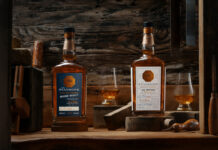Whether it’s for World Gin Day or not a varied range can win with customers

With the massive popularity of gin across the UK and overseas, it should come as no surprise that there is now an official ‘day’ for connoisseurs to celebrate the spirit.
World Gin Day takes place this year on Saturday June 8, and will be the perfect excuse for gin fans to head into the trade and seek out some new gins and serves.
Whether operators choose to embrace World Gin Day with specific events or signage or not, the popularity of the category means it’s likely to be in demand in Scottish pubs and bars throughout the summer.
And a range of gins covering various styles and flavour profiles will be the best way to capitalise, according to brand owners and distributors.
As an operator, there are now more gins to choose from than ever before.
Sarah Clark, senior trade marketing manager at Caorunn, said the category “continues to grow and evolve” but said licensees should prioritise “variety”.
“There is obviously a huge amount to choose from but they need to think of the customers,” said Clark.
She said the priorities should be “flavours, standard, quality, affordability, and versatility of the gin to make for a classic G&T right through to the creation of cocktails”.
Even a small range of gins can cover several bases, said firms, if each bottle is distinct in its flavour.
“You don’t need to have tens of gins but a good range of, say, five should include some distinctively different gins,” said Bob Fowkes, co-founder and marketing director at Brockmans.
“A good traditional London Dry and a few others with interesting stories and interesting botanicals as key ingredients should meet the need if you are strapped for space.”
The choices can be further narrowed down by choosing gins that staff members are enthusiastic about, advised James Porteous, director and distiller at Electric Spirit Co in Edinburgh.
He said: “Whether that’s a local distillery, a producer who’s run training with your staff or just gins that members of staff are really keen on, if you’ve only got a small range you should know each one inside out, and be able to recommend based on customer preferences.
“In that way, a small list can be much more effective than a large one.”
As the gin category continues to expand it has become more important than ever that brands have an individual look.
You don’t need to have tens of gins but a good range should include distinctly different gins.
Ensuring bottles are visible to customers is an important part of showcasing the category in an outlet, said firms.
“New products, no matter how good they are, need to have a chance to blossom,” said Carlo Valente, director at VC2 Brands, the owner of Boë Gin.
“Licensees should make sure the new line has a clear, visible, prominent position on the gantry from the outset and that bar staff are informed about the product and its recommended perfect serve.
“I would also recommend where possible licensees allow for new lines to be tasted by their customers.”
Craig Rankin, distillery manager at Crafty Distillery, summed it up when he said outlets can make the most of new gins on the back-bar through “education and customer service, with good visibility”.
As well as a good range of gins, it’s also important to offer a varied range of serves. And here, too, customers are said to be more open-minded than they were in the past.
Joanne Motion, UK customer marketing manager at Ian Macleod Distillers, owner of Edinburgh Gin, said consumers are “looking to try alternative serves and unexpected combinations in cocktails”.
She pointed to Edinburgh bar Tonic, which has a cocktail featuring gin and red wine on its drinks list.
If you’re raising the bar on your gin range then you’ve got to do the same with your mixers.
“Mixing gin with other spirits or wines allows existing gin drinkers to try something new but also encourages trial amongst consumers that may usually stick within the wine category, for example,” said Motion.
Dale McQueen, co-founder of McQueen Gin, agreed.
“As the stereotypical ‘gin drinker’ has changed, gin serves have undoubtedly changed with them,” said McQueen.
“There is an argument that gin-based cocktails, flavoured gins and gins with alternative mixtures are becoming equally as popular as the classic G&T; people are becoming more adventurous and it is up to the on-trade to respond in line with this emergence.”
The tried-and-tested gin and tonic isn’t going anywhere, however, and it’s crucial that venues are able to offer their customers the perfect G&T.
Fowkes at Brockmans said the serve “remains overwhelmingly popular” and described the perfect gin and tonic as being presented in a chilled glass, with a lot of large ice cubes, a quality tonic and a garnish that matches that particular spirit.
The innovation in gins has been matched by an equal innovation in mixers, and pairing the right tonic (or other mixer) with a gin is said to make a considerable difference to the experience for the customer.
“There are so many great gins with a huge range of flavour profiles, which can all be paired perfectly with a premium tonic that really complements or brings out these unique flavours,” said Craig Harper of Fever-Tree.
Moira Swan, drinks buyer at wholesaler Inverarity Morton, said there has been “a real explosion” in new tonic waters and mixers as the category has expanded.
“If you’re raising the bar on your gin range then you’ve got to do the same with your tonics and other mixers,” said Swan.
“There are so many delicate degrees of flavour from the botanicals and getting the right match can make all the difference.
“If you’re not sure where to start, speak to your supplier or go straight to the brands. They will tell you what their gin likes.”




















